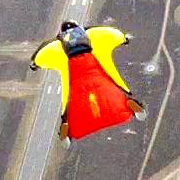
Was: Recommended specs on reserve exit weight, do you go over max?
By
phoenixlpr, in Gear and Rigging
Recommended Posts
fcajump 164
QuoteQuote
F=MA
F= force
M=mass
A=acceleration
---------------------------------------
F=m * a is one side of the equation.
Here is the other side:
F = c * A * v^2
where A is the area of the canopy
V is the speed
c is a coefficient
m * a = c * A * v ^ 2
As you see lager acceleration/deceleration belongs to bigger mass,because forces in this system does not depend on the mass of the system.
c is deppending on the shape, air desity....
A the area of the canopy is constant
V is the deployment speed
---------------------------------
I will agree with your initial equations, however...
1. c and A will be constantly changing during the deployment
2. v (velocity at deployment) is a function of:
m (mass)
c2 (shape, air density of freefalling body prior to deployment), and
A2 (the freefalling body's area)
Finally, it is common practice in modern science to take the theoretical equations and place them in the lab for validation. As we have both test results and actual experiences that seem to show that (in some combinations) overloaded and/or overspeeded canopes (and harnesses) have/will fail due to excessive stress, it seems that the mathmatical model is itself flawed.
As a heavier jumpers, who is a self-proclaimed chicken-sh!t, I will heed the warnings of the manufacturers and testers who have more practical experience with this stuff than I. (Matter of fact, this is why I retired a reserve...) To me, failure of a reserve system (including harness) because someone wanted to second guess the test results is unacceptable. If you want to be a test jumper or designer, go for it, but understand that is what you are doing when you go outside the placarded limits.
Just my rant.
Jim
In any case, but that is not depending on the massQuote1. c and A will be constantly changing during the deployment
We assumed that we don't exceed maximum deployment speed.Quote
2. v (velocity at deployment) is a function of:
m (mass)
Quote
c2 (shape, air density of freefalling body prior to deployment), and
A2 (the freefalling body's area)
QuoteIf you want to be a test jumper or designer, go for it, but understand that is what you are doing when you go outside the placarded limits.
That was not a question.
SethInMI 174
I did some more thinking about this, and ran some spread sheet numbers to try and make some sense of it.
In my spreadsheet I assumed a parachute was completely open (a round) and checked to see how fast it would stop with different weights.
I believe what happens is the heavier jumper does cause the parachute to open more slowly, but this subjects the lines and canopy to the high opening drag forces for a longer period of time which is what will cause the failure.
Now a slower opening will change this, as has been pointed out, but the fact remains, a heavier load causes a longer deceleration which subjects the canopy to high drag forces for a longer period of time, which is tougher on the lines and fabric.
Seth
As you see the peak forces are the same.
AFAIK textiles are rate by the peak break force.
billvon 3,076
Here's one effect:
A light test object is dropped at a high speed. The reserve opens. Due to the high speed, elements of the parachute begin to overstress and elongate. Meanwhile, the force on the test object (caused by drag) decelerates it very quickly. Lower speed = less force on the elements of the parachute under load; the parachute does not ultimately fail (although some parts of elongated/saw a lot of stress during the opening.)
A heavy test object is dropped at a high speed. The reserve opens. Due to the high speed, elements of the parachute begin to overstress and elongate. Meanwhile, the force on the test object (caused by drag) decelerates it more slowly, since the mass is higher. Higher speed = more force on the elements of the parachute under load; the parachute fails.
SethInMI 174
As you know, Fd=Cv^2 (where C is area and drag coefficent and some other things). If a parachute is allowing a 220 lb person to descend at a constant rate of 10mph then 220 = C (10mph)^2. So C = 49 in SI units. Knowing C means that one can solve Fd=Cv^2 for any velocity (assuming the parachute has the same shape), and find the drag force for a given velocity (say 120mph).
Then I used A = Fd/M for the 220lb weight and got deceleration A, which slows the parachute to a new velocity, which creates a lower drag force, which creates a smaller A, etc. (Someone better at math please provide a formula, I just iterated a spreadsheet).
Now it takes time for the parachute to deploy, so C is changing during deployment, but I think the basic math is ok. My calculated deployment took less that 0.1 sec, and travelled a distance of about 8 feet, but that is fully open at terminal. If my math (excluding assumptions) is off, let me know.
Seth
SethInMI 174
The difference is dramatic. There are two main mechanisms "fighting" eachother. As the parachute opens Drag increases, but that causes Speed to decrease which decreases Drag.
Now it is easy to see that increased weight causes increased peak forces on the canopy lines. If you download the sheet, change the values in:
J23 for exit weight
L23 for opening speed
Q20 for opening time in seconds
Watching the results on the chart, it is very evident that larger masses cause higher peak loads. Try a very large mass like 20000 lbs. The force just keeps ramping up, enough to blowup the chute like that cargo parachute that opened early.
Seth
Quote
A canopy does not "know" about the suspended weight on deployment, only the airspeed. So why would it blow up?
I'm aware that I might use it beyond its certification.
You haven't been included on many drop test progams have you?
In the "real world" Stuff like this happens all the time. That's how the "industry" works stuff out. What you are currently using is a DIRECT result of the drop testing done within that industry. Basic physics (in the real world) will hold true and theoretical science is still the underlying foundation to what happens during deploment, but in "real world " situations things become a little bit messier. In this realm nothing is going to be "text book" That's how it is, like it or not! Get used to it.
Mick.
Mick,
Looks like a lot of time was wasted. All those tests could have been done with just a couple of 10 pound shot bags.
SethInMI 174
The only difference between this and previous one is how I ramped up C in Fd=Cv^2. In the previous spreadsheet, I increased C linearly. In this one, C increases at a quadratic rate. Since C is proportional to the area of the canopy, and area proportional to the square of the radius (for a round), I figured the radius of the canopy increases linearly during inflation (or close to it, and this would roughly apply to squares as well), so C increases quadratically.
The interesting thing is with this spreadsheet, the values in the NAB test that Sparky posted make sense. I can plug in the combinations and see peak forces in the 5000 and 3000 lb range for the various tests with a 2 second opening time. This gives me some confidence that I am in the neighborhood of reality with the model that I have come up with.
Now obviously this is just an approximation of the actual forces involved, but it further demonstrates the basic point I want to make: Heavier people cause higher forces on the canopy during opening.
Seth
sprtdth 0
In the "real world" Stuff like this happens all the time. That's how the "industry" works stuff out. What you are currently using is a DIRECT result of the drop testing done within that industry. Basic physics (in the real world) will hold true and theoretical science is still the underlying foundation to what happens during deploment, but in "real world " situations things become a little bit messier. In this realm nothing is going to be "text book" That's how it is, like it or not! Get used to it.
__________________________________________________
Sparky, Mick
Obviously these guys have never had to cutaway an "experimental" only to hear (after landing) " But it worked on paper!".
Frank
CRW Diva #58
And yes, heavier loads create higher forces.
QuoteNow obviously this is just an approximation of the actual forces involved, but it further demonstrates the basic point I want to make: Heavier people cause higher forces on the canopy during opening.
It shows what you want to see.
QuoteYour calculations are incorrect opening time is depending on the deployment speed and suspended weight.
QuoteNow obviously this is just an approximation of the actual forces involved, but it further demonstrates the basic point I want to make: Heavier people cause higher forces on the canopy during opening.
It shows what you want to see.
Basicly, small parachutes HATE fat people and (for the most part) vise versa. Not aholelota math in that one!!
Mick.
QuoteBasicly, small parachutes HATE fat people and (for the most part) vise versa. Not aholelota math in that one!!Sly
I'm sorry but I don't have love and hate relationship with my reserve canopy.
QuoteQuoteBasicly, small parachutes HATE fat people and (for the most part) vise versa. Not aholelota math in that one!!Sly
I'm sorry but I don't have love and hate relationship with my reserve canopy.
What do you care? Youv'e already hung it up!! OR HAVE YOU?.............?
I'm betting NOT!!!! @ least for a while.
Mick
I've jumped it, check first post.
SethInMI 174
QuoteYour calculations are incorrect opening time is depending on the deployment speed and suspended weight.
...
It shows what you want to see.
Phoenix:
It is true I don't have a good way to model opening time, and that will affect the calculations. However, if increasing suspended weight makes the parachute open faster, as I think it would, then this would only increase the peak forces on the heavier jumper.
I think you are only seeing what you want to see.
Sparky:
I did take way too much time to build that spreadsheet. I am glad I got something out of it that seemed to make sense, but I wish it didn't take me so long.
QuoteIt is true I don't have a good way to model opening time, and that will affect the calculations. However, if increasing suspended weight makes the parachute open faster, as I think it would, then this would only increase the peak forces on the heavier jumper.
Heavier load had longer opening time and high average opening forces, but peak forces were the same in your previous simulation.
bch7773 0
then a reserve that is supposed to open in 500 ft and save your life might take 1000 ft and you go splat.
MB 3528, RB 1182
Quoteeven IF what you are saying is true, that heavier loads cause slower openings....
then a reserve that is supposed to open in 500 ft and save your life might take 1000 ft and you go splat.
That can be true. I think the blow up is a myth.
SethInMI 174
I will try once more to convince you, by trying something that is commonly done in engineering when testing a formula: try the extreme case to see if that makes sense. Here I ran a 15k lb load from 160mph, simulating the cargo deployment blowup that was mentioned earlier. The kink in the load graph is where the chute finishes deploying.
If you deploy a 15k lb skydiver shaped load at 160mph, it would start to accelerate, then slow as the chute opened. The new terminal velocity for such a load would be ~80 mph, which is one reason you would need more than one chute to stop the load. The other reason is the peak load forces for this opening are >50k lbs, even though peak g forces are only about 1 g. At 50k lbs the parachute will blow up.
You can modify the opening time a bit, but the fact remains, higher suspended loads cause higher loading forces on the chute during opening.
Other than getting a trusted parachute designer to personally explain things to you, I don't know what else to say.
Seth
Parks College Parachute Research Group
Outline of the presentation at the 2001 Parachute Industry Association Symposium
It is worth reading.
QuoteSkydivers have asked us this question all the time: When does a jumper feel the greatest force from his/her risers? Does opening shock occur during the slider-descent phase or during the other two phases of parachute inflation? As mentioned before, the answer depends on the specifics of the parachute design being flown. In particular, it depends on:
1) The size of the pilot chute and whether it is of a collapsible type;
2) The size of the slider;
3) The size of the main parachute;
Other factors may also enter into the picture, but to a lesser extent, such as: the amount of steering line paid out by brake stowing, fabric porosity, suspended weight, etc.
So blowing up because of overload is just an unconfirmed a myth.




.thumb.jpg.4bb795e2eaf21b8b300039a5e1ec7f92.jpg)

except my reply? what gives?
From slotperfect: Clipping the original content is not an easy process, nor is it perfect. Here is your reply resurrected from the original thread . . .
Share this post
Link to post
Share on other sites